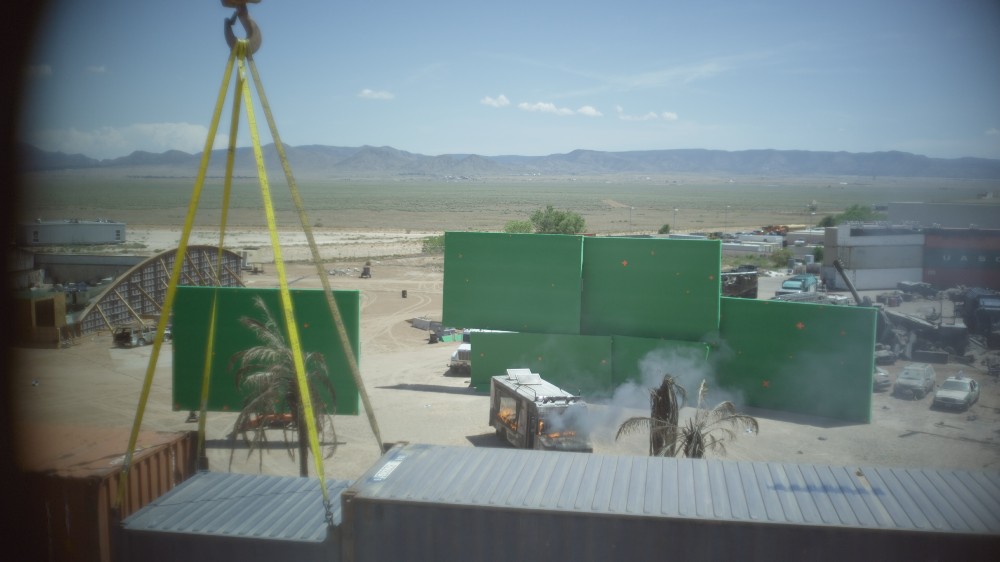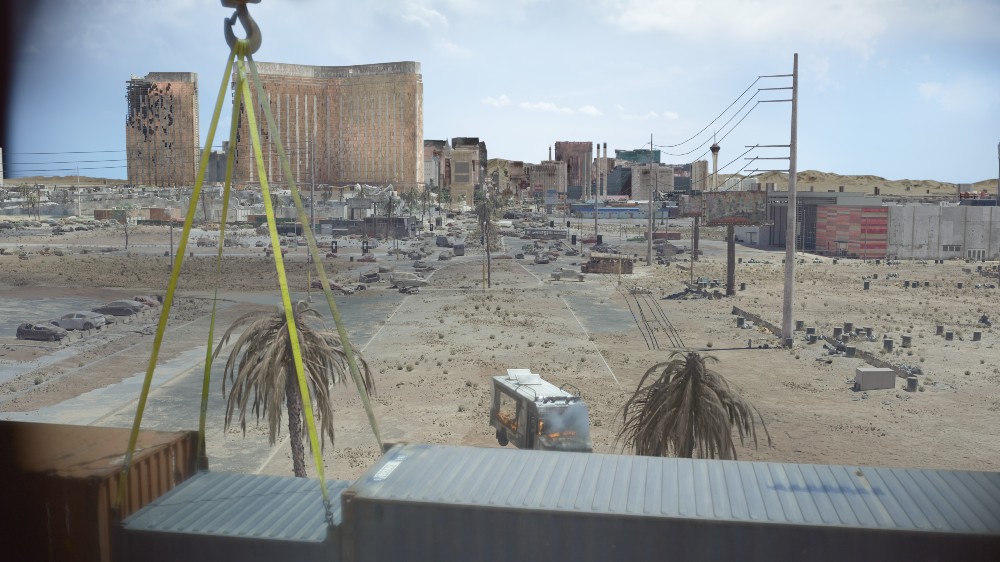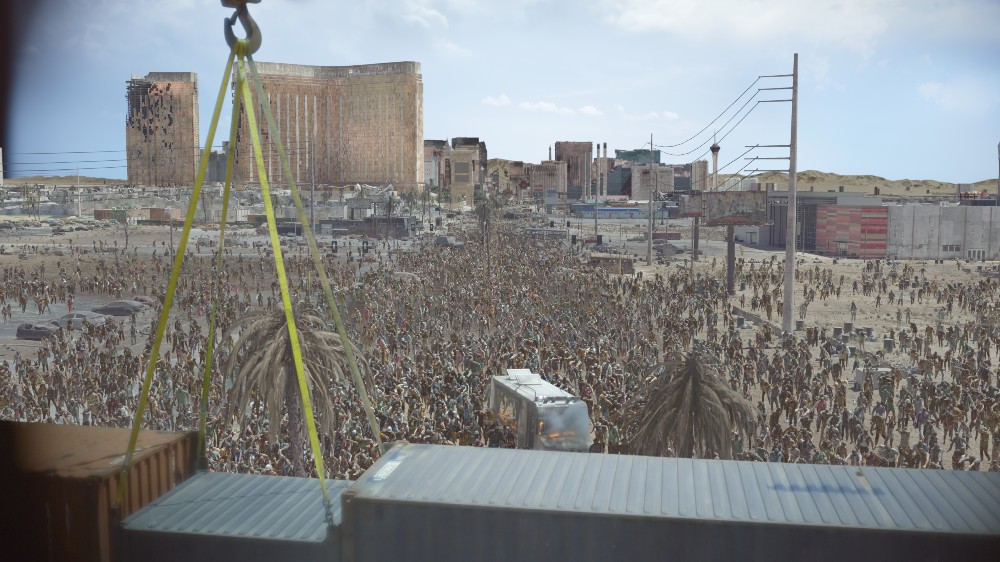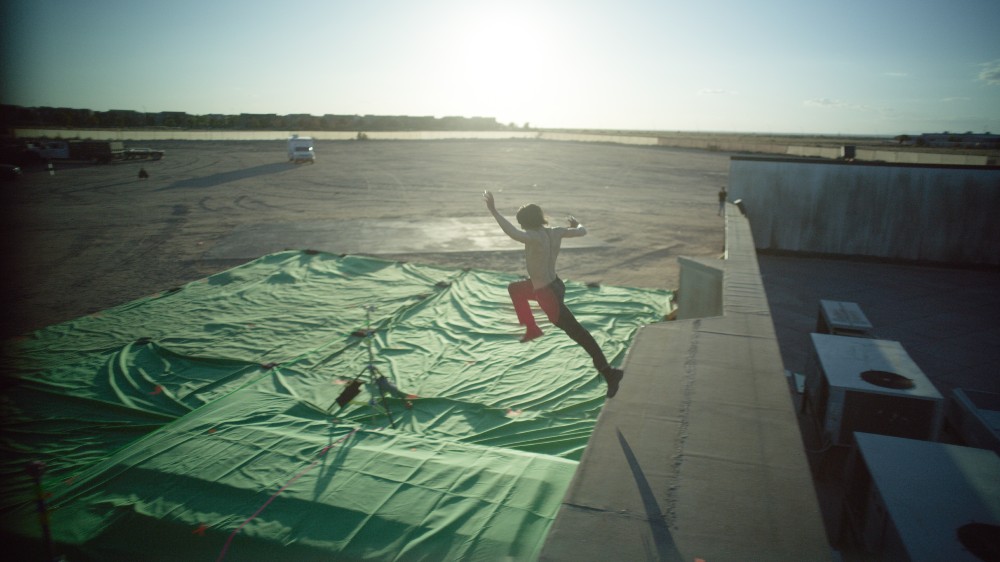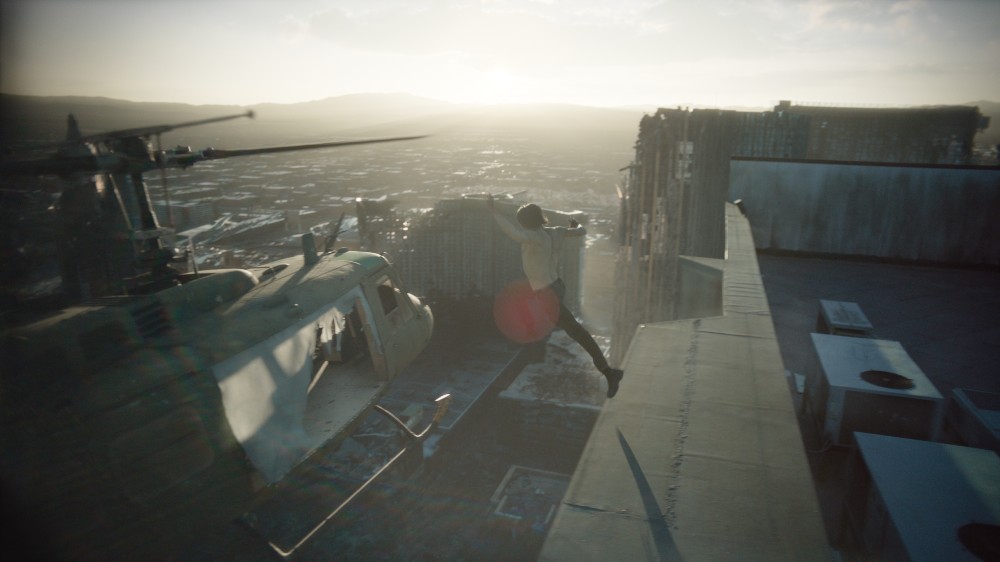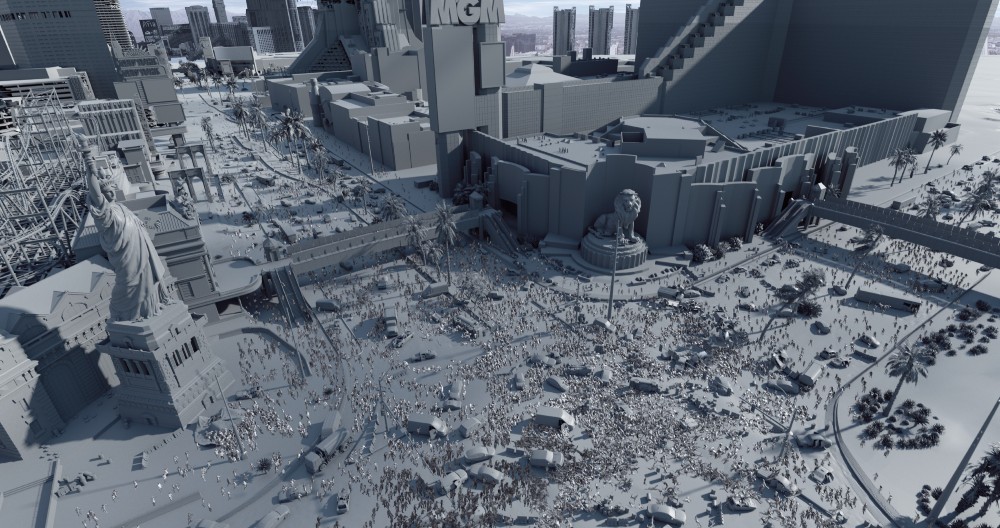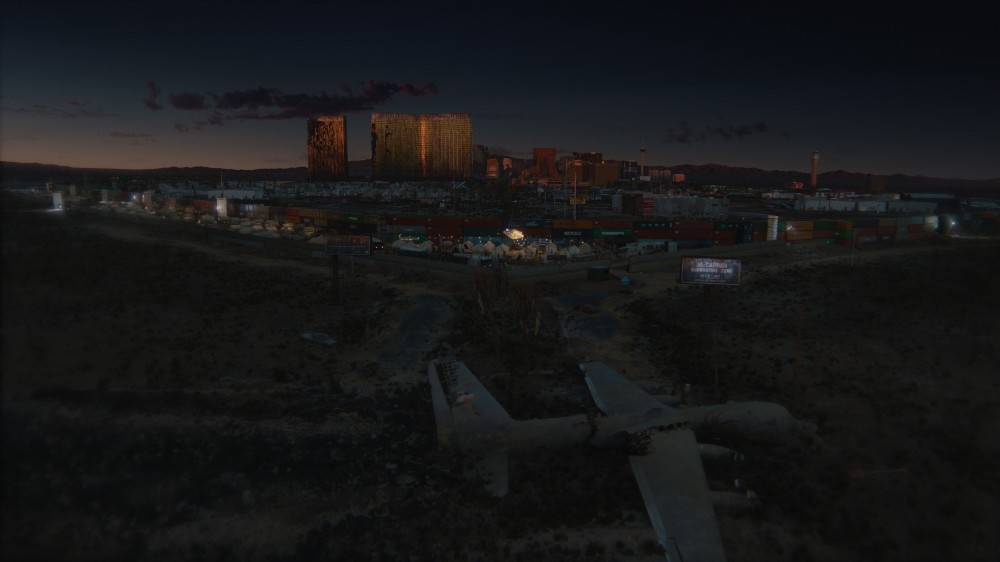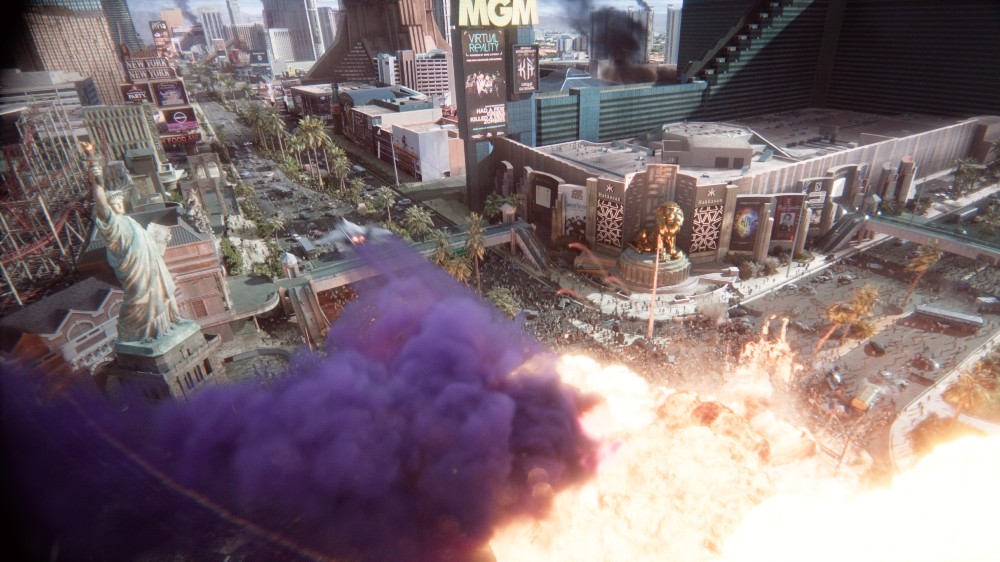
When you watch a Zack Snyder movie, you can almost guarantee a number of things: Insane action unlike anything you might see elsewhere, amazing camerawork, and a ton of the most groundbreaking visual effects. That’s definitely true with Snyder’s latest, Army of the Dead, now streaming on Netflix.
It stars Dave Bautista as Scott Ward, a former military man hired by a rich businessman to lead an unruly team of mercenaries into a Las Vegas that has been overrun by flesh-eating zombies. Their mission is to find and retrieve $200 million stored in a vault deep below one of the businessman’s luxury hotels, but first, they have to get into the city that’s been cordoned off and about to be nuked to get rid of its undead inhabitants.
The challenge faced by Ward and his team is almost mirrored by the challenge faced by Snyder’s VFX team, who had to create a full 3D model of a decimated Las Vegas, literally thousands of undead creatures at times — including Valentine, the undead tiger once belonging to Siegried and Roy — all sorts of bullets and gun shrapnel, not to mention the gory effects of said ammo hitting its mark. And just when they thought they were finished, they needed to replace a key character in the movie with a different actor, which involved especially fine-tuned VFX work.
Army of the Dead would be Snyder’s first time working with Marcus Taormina, who had previously worked as a Visual Effects Supervisor on earlier Netflix movies, Bright and Bird Box.
Below the Line had a long phone conversation with Taormina about making the movie, so long that we’re taking part of this interview and running it separately next week.

Below the Line: I usually like starting interviews just by finding out about one’s personal background. What was your journey into VFX?
Marcus Taormina: I actually have a computer science and engineering background, since I started to go to school for that. A year in I was like, “You know, I don’t know if I want to do coding. What have I always really enjoyed doing?” I really thought hard about it, and actually, it was creating media, creating fun videos and whatnot. I actually jumped ship and went to the Media Studies program in college. There, I actually dove into the college TV station at the time, and that’s where I kind of self-taught a little bit of Visual Effects 101. Filming in front of the green screen, pulling keys, animating a bit, not only at the TV station, but then in school, kind of self-taught and then also learned from the classes. Then one day, my friend, who I had met through the TV station, we’re like, “Let’s just move out to Los Angeles. Let’s just do it.”
We were on the East Coast at the time, so we dropped in right as the writer’s strike was happening, so I’d say, it’s almost 13 years ago now. So there was nothing aside from reality TV, so we both got jobs in reality TV, but at one point, we had an opportunity to jump ship over to feature films, which is what I really wanted to do. I actually landed into the visual effects world, into post where they were actually pulling all the work from one of the facilities and starting to parse it out to new facilities. I had to learn very quickly what I didn’t already know about it, and in that process, I realized, “Oh, my God, this sounds like everything that I love, about making movies, making media. There’s a computer science background to it, there’s a creative background to it, there’s also a photography background to it.” That’s where I totally fell in love with it and kind of became immersed with it. And then through there, I just met some really great people along the way that taught me, while maybe I taught some of them some other things they didn’t know on the production side. I would learn from my supervisors, either at the facility level, like kind of do a trade off, where they would show me a lot of inner workings at a facility, while I would then say like, “On the production side, this is kind of how we operate with this.” That’s kind of the short, abridged version of it.
BTL: Do you work out of a specific VFX house?
Taormina: I’m a freelance visual effects supervisor, and I didn’t work in a facility but I’ve been on the production side, and I’ve had both supervisors that I learned from either full-on freelance or come from the facility side to the freelance side or the client side, if you will. A lot of what I learned along the way was from the facility supervisors that came to the client side.
BTL: Do you specialize in one particular field or are you more of a generalist?
Taormina: Just bouncing around. It feels like I’ve kind of fallen into a little bit — which is great because it was like what I did when I was younger, it was like my fascination — is kind of the horror/zombie genre of sorts. I think what worked really well for Army of the Dead. There was kind of a melding of that plus this world-building that I really enjoyed. So you hit the horror aspect of it, you get the scary aspect of it with the zombies, and then you obviously get the world-building with our Vegas build.
BTL: How did you connect with Zack? I know he’s been working with “DJ” Desjardin, who has gone back to Watchmen but he ended up doing Godzilla vs. Kong. Did he connect you with Zack?
Taormina: I know of DJ, I’ve met him once. He’s a great guy. Zack and him have this great history together, and I would never replace that, but actually, through Army of the Dead, what kicked up was Justice League, which was really great. I was glad that DJ got to have that experience again with Zack, but then also they both had that closure I felt they never got, which was fantastic. I came about this, because it was a Netflix project, and I had just come off prepping Bright 2, and I was in the pool of supervisors for Zack to interview. When I went over to his place, and we started the initial conversation about it, we kind of just hit it off. It felt in some ways like we’d known each other in a past life or something. We just kind of had the same ideas about how we would shoot Army of the Dead. He obviously has a photography background, too, so he kind of got into the nitty-gritty of that. At the time, I believe DJ was busy on Godzilla when we were starting up on Army of the Dead, so the timing didn’t work out. And then, Zack and I had such a great relationship and Zack had to split his time between the two, so I think it worked out. Maybe there’ll be this rotation project to project.
BTL: Zack is really up on VFX and really understands why they’re necessary to make movies. I’m not sure if he actually gets in there to do any of that himself, but he definitely knows how to use them.
Taormina: He could. Jokingly, on Army of the Dead, he wore so many hats that he’s credited for, but there’s like five or six other jobs that he did that he’s not credited for, like storyboard artist, so I jokingly one day looked at him, and I’m like, “You could do all of our jobs, including mine.” But I think what’s great about him is that he respects the process, and he brings people in with him that he trusts that will have his back for those said disciplines. What was great about him is he had his vision, he had his idea, he communicated it well to me, and then I just kind of executed for him. Once we had an understanding of the dialogue between us and then the visual style for the movie, he just kind of let me go. When I felt like there were shots that were in a good place, I’d show him, like the build of Valentine. He initially came up with some really early concept art and a lot of the things — his storyboards, his concept art, even a script for the most part — it doesn’t change much like once he’s like, “That’s it. That’s it.” There’s times on the day where we discover things. For the most part, it’s been great, because he just let me execute, and then we developed a visual bond together. He trusted me to do my thing, and then I’d bring it to him. We had conversations about it, and it was just a fluid process.
BTL: What was the time frame when you get involved?
Taormina: I think this past March was two-ish years by the end when it was all done. I got involved very early on. At the time, there was just a line producer, there was the AD department. There were some keys that he used before, department heads, but I really was kind of one of the new guys that came on. As you mentioned, he’d worked with DJ for so long, and there was a Production Designer [Julie Berghoff] that was new as well. I got involved early on, but it was good because, again, it felt like Zack and I came from another universe and had already met. We had the same ideas and ideals about how we were going to film the movie. In some ways, we had to buy into the idea that we were going to sell all the visual effects of these big scope and scale shots, but then we were going to crash into really the meat of the story with the characters and such.
We had to film it in an intelligent way so that we wouldn’t blow our visual effects budget. Obviously, we knew there were certain sequences that needed a lot more love than not. From the very beginning, we knew that the montage was going to eat up a ton of resources and money from our budget, but then how can we be smart with our filming throughout the movie that we could allot for other chunks of sequences i.e. the Martin mauling scene to give the care and time that it needed for the show.
BTL: Obviously, Vegas was going to be a big part of what was needed, designing Vegas after the undead attack. What was involved? Did you have to capture a lot of plates of Vegas to start with?
Taormina: Vegas was one of the first conversations we had, once I got on the project. There were two main areas of concern, if you will, with Zack. That was kind of like the first thing I talked about was like, “Where’s your concern with this because I want to help you through visual effects for the storytelling.” One was Vegas. We knew moving forward and for the visual tone of the movie, we wanted it to be as close to the Vegas that everybody knows as possible. We could have gone the other route and said, “Okay, we’ll just put the iconic Vegas pieces in there, but then everything else we can just populate with our faux digital world,” if you will. No one really knows the casinos there, but we’ll just get our hero casinos. But we said, “No, we want to make it exactly like Vegas at the time we captured it.” That was one question that was answered early on.
Number two was that in one of my second meetings, I put together a big Vegas map on a piece of poster board, and I mapped out on microfiche clear paper that you could peel back of like every single scene, and if you flopped it all down, it was a huge overlay of color over a Vegas map and it said, “This is where we go in Vegas and let’s talk about the importance of each intersection in each place.” That got the conversation going between us about, “Maybe we’re in too many intersections, maybe we can actually narrow it down to one or two.” So we can maximize our Las Vegas build, and then also maximize our efficiency and focus on those areas. And then with the other bits and pieces, we can focus less on them from a strategic digital built world point of view.
That really helped, because we ended up doing a lot of the work in our Tropicana intersection, so with that information, I decided I wanted to see this world in 3D. We bought a lower polygon version of Vegas — I think it was Vegas 2011 — and we had a 3D representation of it. From that 3D representation of it, I knew that we could start to basically put it in the computer, and then figure out what was around that area without going there. The consumer version of this is Apple Maps or Google Maps 3D view, but where we could leverage that even more is that we could actually put our still cameras into Vegas, and kind of start to plot out how we would capture Vegas and how much overlap we would need. Within 100 feet, how much overlap does this camera give us so we could maximize the capture there without over saturating ourselves with all the data? I was also able to do some tech-vis of the helicopter escape at the end of the movie, so we knew exactly what we would see when we did that fly out through the helicopter. So armed with all that information, I started to plot out in early stages what was more of a tried and true method of capture from rooftops, capture from the ground, capture from multiple perspectives that would then match to one. We came up with this great plan, it was like four feet by one foot. This huge map, we divided it into eight zones. We had production look over it — we said this is what we want to do, and then we went and pitched it to the hotels. And every single one of the hotels said, “Nope, you can’t go on our rooftop. No, no, no, no…” We’ve had success in the past, like in Manhattan, they’d allow us on corners. So it was like, “Okay, back to the drawing board.” There was an idea that I had early on about this Phase One capture camera — it’s like a 150 megapixel capture — and I thought that maybe what we could do is if we can’t get from that perspective, maybe we could fly us up at that perspective. So we put together a drone with this Phase One on it and did a bunch of 360 stills from the vantage points of the helicopter. So it was about 100 feet, 200 feet, and depending on where we could get on the strip, we were allowed to fly a certain height, which was a first I’m told. They don’t really allow drones, but because we had such a game plan as to how we could capture the strip, they actually approved us on that.
But it wasn’t just a drone. I knew we had to get a 3D representation of the world, so we had terrestrial LIDAR happening, and we also had multiple teams on scissor lifts. That would traverse the strip in each zone on each day, and we would capture as much of the strip as we could that we needed with photos with gigapans and all sorts of data, visual data, and then we also did, like I said, our 3D capture of our Lidar from from the ground.
But that still didn’t solve the rooftops, so I said, “Can we fly a Lidar scanner on a helicopter?” And the answer was, “Let’s take a look.” We actually found a solution to that. We actually did aerial LIDAR as well, and we tied that into our terrestrial Lidar. It created this huge point cloud of data of an accurate representation of what Vegas was. In addition to that, we shot some motion picture plates, looking straight down to the rooftop, so we could see what the rooftops look like when actually ever stepping foot on top of the rooftops. So with all that data, we had a bunch of really talented artists from all over specifically, this was Framestore, Montreal. We crunched that data and we basically had a good worldview of what Vegas was over those 12 days. And then we started to decimate it, and create that destroyed world based on some key concept art from the art department and also the art department’s practical build and what the palette was landing on for our practical sets.
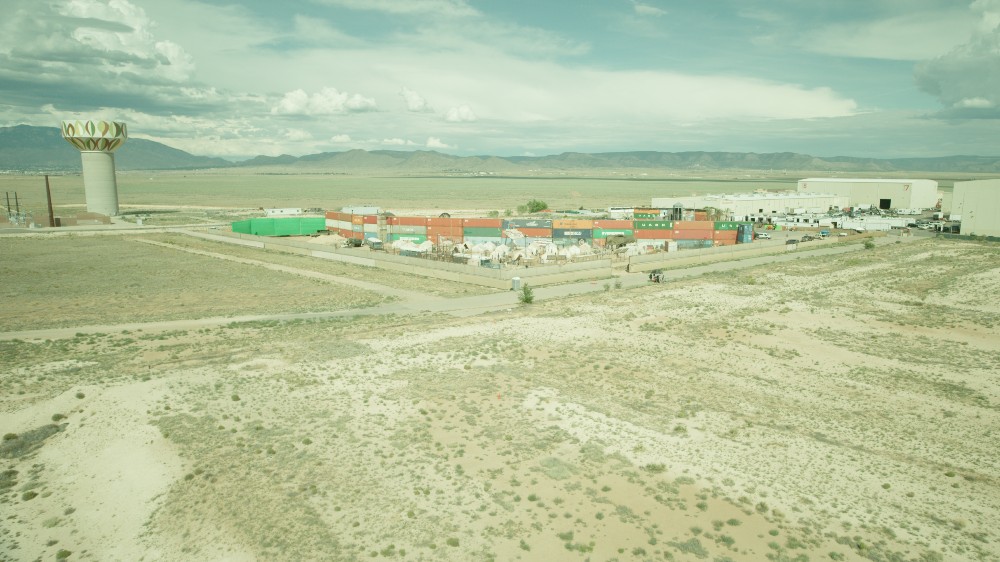
Tying back into the production design versus the visual effects, we’d have a lot of discussions about, “Okay, what are you going to build practically in this world?” The fact that the production designer understood what that world was, was really great, because Julie [Berghoff] and I with Zack would say, “Okay, we’re right in front of the MGM and New York, New York’s over here. So how can we tie in some practical pieces to make it feel tied together from the digital versus practical world?” One great example is the MGM sign itself — the metal piece of it is flopping on our practical set, and in our digital set, we’ve removed some of the “M” so it’s just a nice, fluid transition from digital to practical.
BTL: How much work did you do with the lidars and building in the computer before Zack was ready to start shooting with the actors on a real set?
Taormina: During our principal photography in New Mexico, we were devising the plan to capture Las Vegas. I think it was a handful of months that we had come up with that game plan, then we pivoted and came up with a new game plan. What we also did was we verified it in the computer, so once we plotted where we would capture, like I said, we used the layout model, and we basically ran the whole Strip, and we also used a lot of Google Maps to get a GPS coordinates that we can do a grid from the aerial set. That whole data set was captured. I mean, it was months of planning, but it was captured over 12 days and two nights, like 12 days total, but there were two nights we had to capture. It was upwards of 30 to 40 people at any time, and then taking that data and then actually creating the Vegas that you see on screen took another six months to really get it finessed to the final pixels you see.
BTL: What needed to be built on a soundstage for the actors to interact with before being integrated with the computer Vegas?
Taormina: A lot of our Tropicana intersection that we live in with our principal cast was built in New Mexico, and we shot a lot of it from the South looking North, because we knew the North looking South there was hardly anything on that end of the strip. We parked ourselves at Tropicana. We knew that, I’d say 65 to 70% of the action is in that one Tropicana intersection, so we talked about how we could tie in some very basic structures that would then tie into our digital. I mentioned the MGM sign — other pieces were cars, barrels, and then from our Tropicana location scouting, one thing that we really leaned on a lot were the pedestrian bridges. We had a big pedestrian bridge built out that matched what was in Vegas itself, and then we destroyed that. We didn’t destroy it — the actual physical production designer had it destroyed. So it felt like it was within our world, because in the montage, they do this huge napalm strike on the Tropicana intersection. When we came back to it, we wanted it to feel like it’s been decimated already, and also that it made sense in our digital world it was decimated, or destroyed, rather. So we gave a lot of thought as to how we could marry the practical set pieces into our digital world, and the pedestrian bridge is actually very simple. I won’t say that, because I’m sure Julie’s like, “It wasn’t a simple build!” It was a very simple build at the core. We utilized as much as we could. We did a couple of cheats with it, too, because it’s a great piece that can be utilized. We shot multiple angles of it for different intersections, so it worked out really well.

BTL: You mentioned Framestore earlier. What were some of the other houses that you used for this show, and did you generally know who could specialize in specific aspects of the movie?
Taormina: For Framestore, I knew they were gonna do what I call the heavy lifting. We knew they had some incredible work with environments, so I knew I wanted to land the Vegas build itself at Framestore. In addition to that, I knew that we wanted to place Valentine at Framestore as well. They had done some really great work that they showed in the beginning. Their supervisor reminded me the other day — there was a moment where I was like, “Let’s just let’s make sure we show the best work” so they actually pulled in some footage of the polar bear from Timmy Failure, the Disney Plus movie. I was like, “This is incredibly impressive. Let’s show it to Zach,” because, like I said, two of the main causes of concern were Vegas and Valentine.
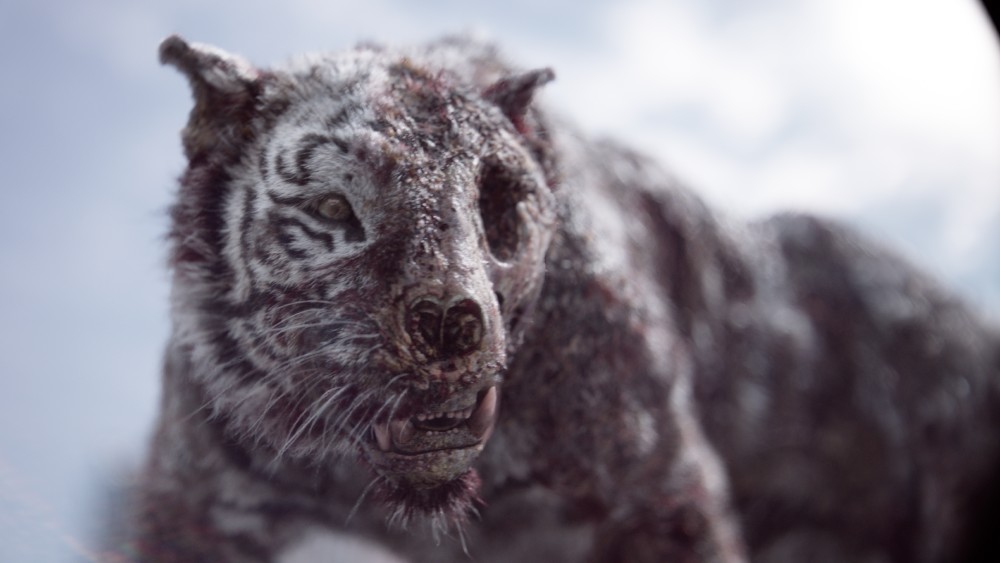
I knew that we could execute Valentine; I just wanted to make sure that it was the proper look. I showed him that, and then we had a conversation. “I think this is the right move. They’re gonna do a great job. They want to do a great job. They have some really great toolsets that we can build on from Timmy Failure.” Obviously, those two big questions were placed at Framestore, specifically the Montreal branch, and then we also utilized them for some really A+ hardcore digital gore, and then we also had Mammal Studios, which is in Los Angeles. I’ve worked with them on just about every show at this point — they do a lot of really great comp work, they did some 2D and 3D blood hits. They’re a big part of the Chambers fight in the hallway there, so they did some really great work. We also had a little in-house team, which was really a crucial part of it that I probably haven’t talked enough about.
We had two artists in-house that were kind of just generalists, they were really talented. I used them for all sorts of things. We’d do crude tech-vis or previs with them on the layout model. I’d take that and once Zack was pretty cool with it, I’d hand that whole digital packet over to Framestore, and then I’d have a brief with them, and we’ve already advanced some of the shots so they can see it in a 1:1 world, and then we’d go, “Okay, here’s what I want to do.” They also helped me develop some of the lens flaring that you see, so the muzzle flashes… I mean, it’s a Zack Snyder movie, so nothing’s just normal, right? So we stylized our muzzle flashes, which was fantastic, but that R&D was done with our in-house team, and we also ended up coming up with some really great toolsets that we passed to all the facilities for our 3D shell casings. So something that’s very small but overlooked in the complication of the whole movie is that all of our guns were gas guns, they only fed just blanks, so there were no shell casings ever aside from the 50 calibers. So muzzle flashes and shell casings had to be added to all the scenes, but we came up with a pretty efficient way, almost like a new gizmo, if you will, that we could pass along to facilities. So the same look with both the muzzle flashes, but also our 3D shell casings. That worked out really, really flawlessly. And then we also had Instinctual do some work, and we also had Crafty Apes come on, and they did some 2D and 3D gore head hits, as well.
BTL: Are you working on anything else right now?
Taormina: I’m in between jobs right now, taking a little break, so I’m kind of floating out there right now, seeing what’s next.
We had such a great time talking with Marcus, but eventually, we got into talking about the process of putting Tig Notaro into the movie when she was hired to replace comedian Chris D’Elia after controversial accusations that made it important to replace him in the movie. You can learn in great detail how they did exactly that next week in our “Making the Scene.”
Army of the Dead is now available on Netflix. All pictures courtesy of Netflix, except where noted.

